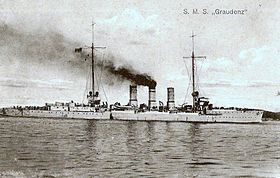SMS Graudenz

|
|
| Overview | |
|---|---|
| Type | Small cruiser |
| Shipyard | |
| Order | 1911 as substitute for Prince Wilhelm |
| Keel laying | 1912 |
| Launch | October 25, 1913 |
| Namesake | City of Graudenz |
| 1. Period of service |
|
| Commissioning | 1914 |
| Decommissioning | March 10, 1920 |
| Whereabouts | Italian spoils of war; Scrapped in 1938 |
| Technical specifications | |
| displacement |
Construction: 4912 t |
| length |
KWL : 139 m |
| width |
13.8 m |
| Draft |
5.75-6.08 m |
| crew |
21 officers and 364 men |
| drive |
2 sets of steam turbines with 26,000 HPw at 410 rpm on 2 shafts |
| speed |
27.5 kn |
| Range |
5500 nm at 12 kn |
| Armament |
|
| Boiler system |
|
| propeller |
2 three-winged ( 3.5 m) |
| Armor |
|
| Electrical system |
2 turbo and |

SMS Graudenz was a small cruiser of the Imperial Navy , which was built from 1912 to 1914 at the Imperial Shipyard in Kiel. Sister ship was the small cruiser Regensburg .
Delivered to Italy in 1920, she served in the Italian Navy as Ancona from 1925 to 1935 .
Building history
With the two cruisers of the Graudenz class , the imperial navy returned to three-chimney ships in 1912. The launching of the ship was on 25 October 1913 the commissioning took place on August 10, 1914 the former Division Chief of the Naval Cabinet, Captain Karl von Restorff . The ship was 142.7 m long and 13.7 m wide and had a draft of 6.0 m. The maximum displacement was 6,382 t, empty the ship had a displacement of 4,900 t. It was powered by two steam turbines with a total of 26,000 hp , which enabled a top speed of 27 knots . Originally, the ship was equipped with twelve 10.5 cm guns, anti-aircraft cannons and two torpedo tubes below deck. The crew consisted of 21 officers and 364 NCOs and men.
War effort
In September 1914, the Graudenz ended its trials. They were assigned as flagship to the second leader of the torpedo boats , the previous commander, Captain Karl von Restorff, and at the same time belonged to the fourth reconnaissance group led by him in personal union. The cruiser performed outpost and security services in the North Sea. He also took part in forays into the east coast of England . On January 24, 1915, the Graudenz , under the leadership of Frigate Captain Püllen, took part in the battle on the Dogger Bank. In August 1915, the ship with the II reconnaissance group moved to the Baltic Sea for a short time . A month later the Graudenz was involved with the Pillau in the rescue of the torpedo boats V 1 and G 12 at Horns Reef , which had rammed each other. G 12 sank after explosions with 47 dead.
From October 26, 1915 to February 18, 1916 the Graudenz lay in the Imperial Shipyard in Kiel . During this time, the 10.5 cm guns were exchanged for seven 15 cm guns. In addition, two 8.8 cm anti-aircraft guns , two 50 cm torpedo tubes on deck, and a device for the transport of 120 mines were installed.
Then the Graudenz went back to the usual missions in the North Sea. On April 22, 1916, she ran southwest of the lightship Amrumbank on a mine . They towed the torpedo boat S 51 and the small cruiser Frauenlob to Wilhelmshaven . The ship was not ready to sail again until September 13, 1916.
In the last two years of the war, the Graudenz performed outpost and security services in the German Bight again . In March 1918 she took part in the trade war in the Skagerrak .
Post war fate
After the end of the war, the Graudenz initially remained in service. She did not have to go to internment at Scapa Flow , but instead was placed under the security association of the North Sea Commander . On November 5, 1919, she was deleted from the list of warships and finally decommissioned on March 10, 1920.
Then came the order for extradition. On June 1, 1920 the Graudenz was delivered to Cherbourg as ship E and then handed over to Italy . On May 6, 1925, she was put into service as Ancona for the Italian Navy , transferred to the reserve in September 1935 and finally scrapped in 1938.
Commanders
| August 10, 1914 - September 8, 1914 | Sea captain Karl von Restorff | 1871-1946 | Rear admiral |
| September 8, 1914 - April 1916 | Frigate captain / sea captain Theodor Püllen | 1871-1931 | Vice admiral |
| May 1916 | Lieutenant Carlo Peucer on his behalf | 1882 - | |
| May - June 1916 | Lieutenant Richard Feldt on his behalf | 1882-1918 | |
| June - July 1916 | Sea captain Karl Less | 1899-1941 | |
| July 1916 - January 1918 | Frigate Captain Rudolf Madlung | 1874-1940 | |
| January 1918 - June 1919 | Corvette Captain Friedrich Bessel | ||
| June 1919 - March 10, 1920 | Corvette / frigate captain Bernhard Bobsien | 1878-1934 | Rear admiral |
literature
- Gerhard Koop / Klaus-Peter Schmolke, Kleine Kreuzer 1903-1918, Bremen to Cöln Class , Volume 12 Ship Classes and Ship Types of the German Navy, Bernard & Graefe Verlag Munich, 2004, ISBN 3-7637-6252-3
Web links
- Website German Protected Areas
- Overview Graudenz class on worldwar1.co.uk (Engl.)
- Graudenz class on historyofwar.org (Engl.)
